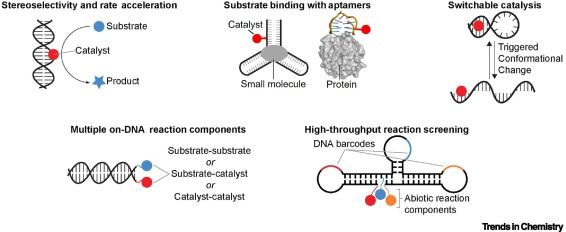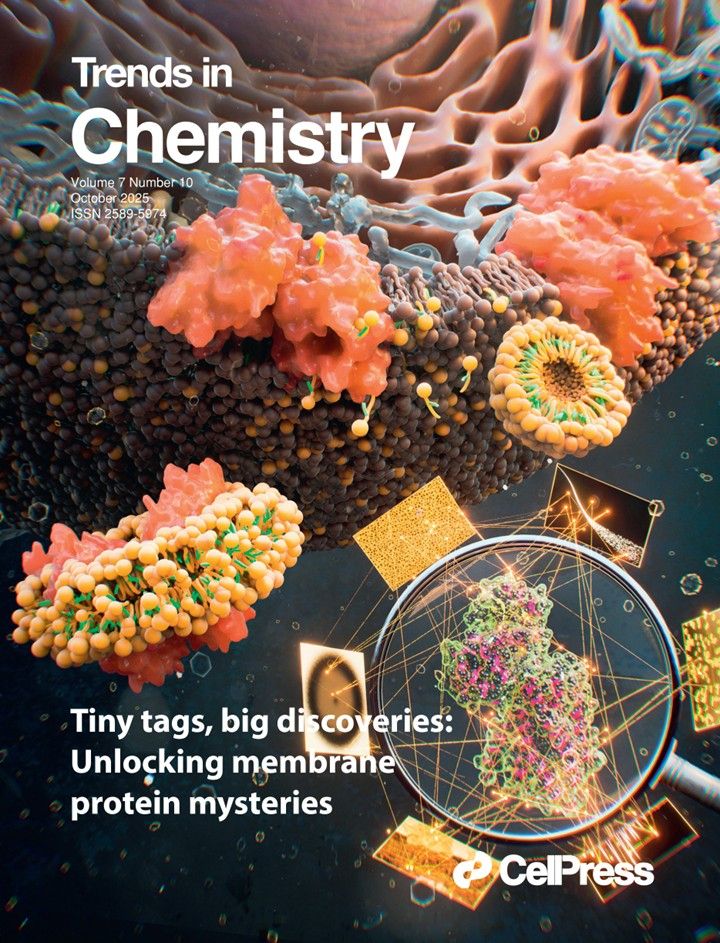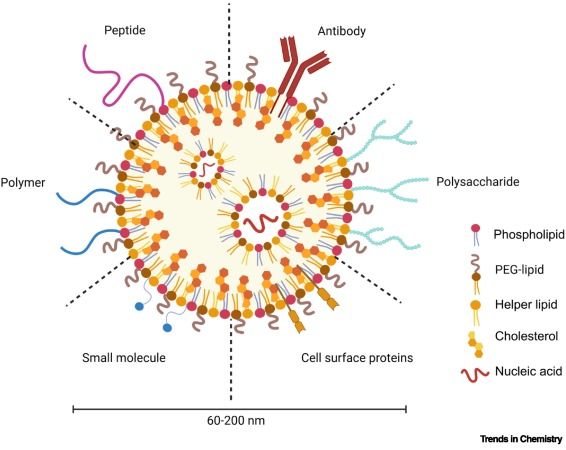
DNA-scaffolded catalysis
A longstanding goal in supramolecular chemistry has been to enhance the functionality of abiotic catalysts by attaching them to 3D scaffolds, analogous to enzyme active sites. Recent advances in DNA synthesis, DNA sequencing, and DNA-compatible chemical reactions open opportunities to enhance the function and accelerate the discovery of abiotic catalysts by interfacing them with DNA. Here we highlight the ways in which DNA has been merged with abiotic catalysis, including stereoselectivity, regioselectivity, switchability, and scaffolding of multiple reaction components. Furthermore, we describe how the programmable self-assembly and information-encoding properties of DNA enable high-throughput screening of abiotic chemical reactions. We discuss key advances, challenges, and opportunities to harness the potential of synthetic DNA as a scaffold for abiotic catalysis.
Online now: DNA-scaffolded catalysis
08.11.2025 13:43 — 👍 0 🔁 0 💬 0 📌 0
Transforming bio-derived DNA into biotechnology
DNA technology is rapidly expanding, with recent advances pushing functional DNA-based materials toward larger scales. Yet producing chemically modified DNA beyond the milligram-scale remains prohibitively expensive, challenging, and relatively unexplored, limiting industrial and translational use. This review article highlights emerging strategies for sourcing, modifying, and purifying DNA at scales relevant for materials and biotechnology. We compare bio-derived DNA sources (e.g., phage, plasmid, and genomic DNA) to conventional synthetic methods and examine their trade-offs. Critically, we re-examine recent and classic literature to identify chemical and enzymatic reactions practical for modifying bio-derived nucleic acids at relevant scales. Finally, we discuss scalable purification and characterization methods to support high-throughput workflows, enabling broader use of bio-derived dsDNA in next-generation applications.
Online now: Transforming bio-derived DNA into biotechnology
31.10.2025 19:47 — 👍 0 🔁 0 💬 0 📌 0

Nucleic acid-guided protein-empowered aquatic contaminants sensing
The rapid evolution of nucleic acid-guided proteins (e.g., CRISPR/Cas12a, Argonaute) has positioned them as transformative tools for aquatic contaminant sensing. Their programmability, compatibility with diverse signal transducers, and field-deployable designs enable unprecedented on-site environmental monitoring. This review outlines the fundamental mechanisms of nucleic acid (NA)-guided proteins, critically analyzes implementation strategies (including field-deployable platforms), and systematically highlights their applications in the sensing of aquatic pollutants. We further discuss current challenges and future research directions to further advance multiplexing, sensitivity enhancement, artificial intelligence (AI)-assisted engineering, and integrated on-site detection areas. By providing comprehensive insights into this emerging field, we hope that this review will serve as an important resource for researchers developing next-generation NA-guided proteins-based environmental surveillance tools to address ‘One Health’ challenges at aquatic interfaces.
Online now: Nucleic acid-guided protein-empowered aquatic contaminants sensing
30.10.2025 12:42 — 👍 0 🔁 0 💬 0 📌 0

🧪 Check out the October issue of Trends in Chemistry!
Our cover article and artwork comes from Pil Seok Chae & team at Hanyang University. Their Review highlights novel design strategies for pendant-bearing detergents to investigate membrane proteins.
📰 Read more at: www.cell.com/trends/chemi...
17.10.2025 12:05 — 👍 0 🔁 0 💬 0 📌 0

Smart lipid nanoparticles: the chemistry driving targeted therapeutics
Recently, lipid nanoparticles (LNPs) have transformed drug delivery, particularly for nucleic acid vaccines and gene therapy. LNPs provide biocompatibility, enhanced bioavailability, and controlled release. However, nonspecific distribution remains a limitation for conventional LNPs. This review highlights the evolution of targeted LNPs (tLNPs) as precision drug delivery systems, with emphasis on recent innovations in surface functionalization, lipid composition tuning, and organ-specific delivery. Unlike prior reviews focused on general LNP formulations, we explore active targeting strategies, including ligand conjugation and structure-driven targeting, that redefine therapeutic precision and reduce off-target effects. This review presents a comprehensive overview of how tLNPs are advancing towards clinical applications across immunotherapy, gene editing, and personalized medicine.
Online now: Smart lipid nanoparticles: the chemistry driving targeted therapeutics
11.10.2025 12:42 — 👍 1 🔁 0 💬 0 📌 0

Congratulations to the 2025 Nobel Laureates in Chemistry!
@cellpress.bsky.social #MOFs #ChemNobel
08.10.2025 16:19 — 👍 0 🔁 0 💬 0 📌 0

View program and register
Join a special panel discussion exploring the plastics economy, and ask your publishing questions to our experienced Cell Press editors Vjekoslav Dekaris (Chem) & Xiaoxiao Qiao (Chem Catalysis) @CellSymposia #CSPlastics2025
Register: http://dlvr.it/TNVYYf
06.10.2025 09:10 — 👍 0 🔁 1 💬 0 📌 0
Thank you so much for the stellar contribution! Excited to see it in the special issue soon...! 🎉
03.10.2025 17:56 — 👍 1 🔁 0 💬 0 📌 0

Uncovering RNA grammar in driving synthetic condensates
Ribonucleoprotein complexes are key players in driving natural cellular condensates. Recent studies have further shown that RNA itself, via highly modular and programmable self-assembly and multivalent interactions, can also function as scaffold for engineering synthetic condensates. These synthetic RNA-driven condensates exhibit unique molecular and material properties in compartmentalization, target selectivity, switchability, and spatial controllability, together with potential functions as chemical and/or genetically encodable tools in reaction control, biosensing, RNA network regulation, origin of life and artificial cell studies, and therapeutics. Here, we describe the molecular features, design principles, and physical and material properties of these emerging RNA-driven synthetic condensates, as well as the potential applications and current trends in the field.
Online now: Uncovering RNA grammar in driving synthetic condensates
26.09.2025 19:50 — 👍 0 🔁 0 💬 0 📌 0
Expanding epitranscriptomics to non-enzymatic RNA modifications
Cells regulate responses to external stimuli and control cell fate through reversible modifications on proteins, DNA, and RNA typically introduced by enzymes. Next to these well-known enzymatically installed modifications, covalent modifications can also occur on the same biomolecules through spontaneous reaction with small molecules taken up from external sources or generated endogenously (e.g., byproducts of metabolic processes). These so-called non-enzymatic covalent modifications (NECMs) have been mainly studied on proteins and DNA, but their biological role on RNA remains mostly underexplored. This review surveys identified and predicted RNA NECMs, explores their impact on RNA structure, stability, and function, and examines their link to diseases. Finally, we discuss regulatory mechanisms of non-enzymatically modified RNAs and their potential significance in cellular dynamics.
Online now: Expanding epitranscriptomics to non-enzymatic RNA modifications
22.09.2025 19:48 — 👍 1 🔁 0 💬 0 📌 0
International Research Training Group 2991 on "Photoluminescence in Supramolecular Matrices" - IISER Thiruvananthapuram 🇮🇳 and JMU Würzburg 🇩🇪
Website: https://www.uni-wuerzburg.de/irtg2991
Self-assembly, supramolecular structures, functional properties and device applications of organic dye materials @uni-wuerzburg.de. Account managed by group members.
https://www.chemie.uni-wuerzburg.de/oc/wuerthner-group/
Using quantitative, data-driven approaches to make synthetic chemistry more predictable. Phase II CCI #NSFFunded
🌐 https://ccas.nd.edu/
📷 https://www.instagram.com/nsf_ccas/
Lecturer in Chemistry @ University of Aberdeen 🏴 | Liquid Crystals💧💎 | Cat Mom to Raven and Raja 🐾
Peptide self assembly, evolution, and bioinorganic chemistry. Assistant professor at University of Illinois Chicago (UIC)
ainguyenlab.com
Developing cutting-edge analytical platforms for comprehensive studies of biological systems. Specializing in ambient ionization mass spectrometry profiling, imaging, and real-time volatile organic compounds (VOCs) detection.
Postdoc@ETH Zürich Polymer Chemistry Group
PhD@SNU Chem
The Sofer Research Group located, led by Prof Zdeněk Sofer. We are located at the University of Chemistry and Technology Prague (VŠCHT Praha/ UCT Prague), Czechia. Research on 2D layered materials and wide range of applications.
https://sofergroup.cz/
Group Leader @TLClab @ETH_Materials, Interested in Polymer Science, Organic Chemistry and Material Science. Alumni @Caltech @MerkleInstitute @unifr
Incoming Assistant Professor at Northwestern University. Current postdoc in Nocera Lab at @ Harvard; Former: PhD @ Johns Hopkins (Goldberg Lab); UG @ UF (Murray Lab); he/him
Computational chemist @ Department of Chemistry "Giacomo Ciamician", University of Bologna, Italy
We are a research group at UC San Diego led by Professor Andrew Pun in the Department of Chemistry & Biochemistry.
Student-run AP Lab account.
Supramolecular Chemist @cnrs.fr @unistra.fr
Acridinium to Viridium Chemistry
Multi-responsive Components
The Helmholtz Institute for RNA-based Infection Research (HIRI) in Würzburg, Germany is the first institution of its kind worldwide to combine ribonucleic acid (RNA) research with infection biology.
https://www.helmholtz-hiri.de/en/imprint/
Organic chemistry research group at Newcastle University @chemistryncl.bsky.social. Formerly at the FU Berlin.
Doing quantum chemistry at @p_lodz_pl
We are interested in olefin metathesis polymerization mechanisms and synthetic nanotubes based on polymeric aramid foldamers.
www.kilbinger.net
Molecules and words; glycoscientist @BrownUniversity; occasional #sciku; in a relationship with the Dunlop double dot
https://sites.brown.edu/basulab/
















